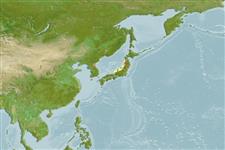>
Perciformes/Zoarcoidei (Eelpouts and pricklebacks) >
Stichaeidae (Pricklebacks) > Alectriinae
Etymology: Alectrias: Greek, alektros, -os, -on = single, married in illegal or unhappy marriage (Ref. 45335).
Environment: milieu / climate zone / depth range / distribution range
Ecología
marino demersal; rango de profundidad 20 - 40 m (Ref. 51666). Temperate
Northwest Pacific: Off Moura Island, Hiranaimachi, Mutsu Bay, Aomori Prefecture, Japan.
Tamaño / Peso / Age
Maturity: Lm ? range ? - ? cm
Max length : 8.2 cm SL macho / no sexado; (Ref. 34853)
Found over muddy bottom at depths of 20-40 meters; usually deeper than its congeners (Ref. 51666). Oviparous, eggs are guarded by the female parent (Ref. 58332).
Life cycle and mating behavior
Madurez | Reproducción | Puesta | Huevos | Fecundidad | Larva
Shiogaki, M., 1985. A new stichaeid fish of the genus Alectrias from Mutsu Bay, northern Japan. Jap. J. Ichthyol. 32(3):305-315. (Ref. 34853)
IUCN Red List Status (Ref. 130435: Version 2024-1)
Threat to humans
Harmless
Human uses
Herramientas
Special reports
Download XML
Fuentes de Internet
Estimates based on models
Phylogenetic diversity index (Ref.
82804): PD
50 = 0.5156 [Uniqueness, from 0.5 = low to 2.0 = high].
Bayesian length-weight: a=0.01000 (0.00244 - 0.04107), b=3.04 (2.81 - 3.27), in cm total length, based on all LWR estimates for this body shape (Ref.
93245).
Nivel trófico (Ref.
69278): 3.1 ±0.4 se; based on size and trophs of closest relatives
Resiliencia (Ref.
120179): Medio, población duplicada en un tiempo mínimo de 1.4-4.4 años (Preliminary K or Fecundity.).
Fishing Vulnerability (Ref.
59153): Low vulnerability (10 of 100).
